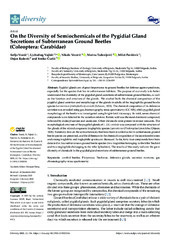Приказ основних података о документу
On the Diversity of Semiochemicals of the Pygidial Gland Secretions of Subterranean Ground Beetles (Coleoptera: Carabidae)
| dc.creator | Vranić, Sofija | |
| dc.creator | Vujisić, Ljubodrag V. | |
| dc.creator | Vesović, Nikola | |
| dc.creator | Todosijević, Marina | |
| dc.creator | Pavićević, Miloš | |
| dc.creator | Radović, Dejan | |
| dc.creator | Ćurčić, Srećko | |
| dc.date.accessioned | 2023-05-11T14:20:15Z | |
| dc.date.available | 2023-05-11T14:20:15Z | |
| dc.date.issued | 2023 | |
| dc.identifier.issn | 1424-2818 | |
| dc.identifier.uri | http://cherry.chem.bg.ac.rs/handle/123456789/5891 | |
| dc.description.abstract | Pygidial glands are of great importance to ground beetles for defense against predators, especially for the species that live in subterranean habitats. The purpose of our study is to better understand the chemistry of the pygidial gland secretions of subterranean ground beetles, as well as the function and structure of the glands. We studied both the chemical composition of the pygidial gland secretion and morphology of the glands in adults of the troglophilic ground beetle species Laemostenus (Antisphodrus) cavicola (Schaum, 1858). The chemical composition of its defensive secretion was revealed using gas chromatography-mass spectrometry (GC-MS), while pygidial gland morphology of the beetle was investigated using bright-field microcopy. In total, seven chemical compounds were detected in the secretion mixture. Formic acid was the most dominant compound, followed by dodecyl acetate and undecane. Other chemicals were present in minor amounts. The morphological structure of the pygidial glands of L. (A.) cavicola was compared with the structure of the glands of the related congeneric troglophilic species Laemostenus (Pristonychus) punctatus (Dejean, 1828). Summary data on the semiochemicals that have been recorded so far in subterranean ground beetle species are presented, and the differences in the chemical composition of the secretions between and among troglobitic and troglophilic species are discussed. So far, forty-four compounds have been detected in four subterranean ground beetle species (two troglobites belonging to the tribe Trechini and two troglophiles belonging to the tribe Sphodrini). The results of this study indicate the great diversity of chemicals in the pygidial gland secretions of subterranean ground beetles. © 2023 by the authors. | |
| dc.language | English | |
| dc.publisher | MDPI | |
| dc.relation | info:eu-repo/grantAgreement/MESTD/inst-2020/200178/RS// | |
| dc.relation | info:eu-repo/grantAgreement/MESTD/inst-2020/200168/RS// | |
| dc.relation | info:eu-repo/grantAgreement/MESTD/inst-2020/200160/RS// | |
| dc.relation | Montenegrin Academy of Sciences and Arts (Grant “Catalogue of Pseudoscorpions of Montenegro”) | |
| dc.rights | openAccess | |
| dc.rights.uri | https://creativecommons.org/licenses/by/4.0/ | |
| dc.source | Diversity | |
| dc.subject | carabid beetles | |
| dc.subject | defensive glands | |
| dc.subject | gas chromatography-mass spectrometry | |
| dc.subject | Platyninae | |
| dc.subject | secretion mixtures | |
| dc.subject | Trechinae | |
| dc.title | On the Diversity of Semiochemicals of the Pygidial Gland Secretions of Subterranean Ground Beetles (Coleoptera: Carabidae) | |
| dc.type | article | en |
| dc.rights.license | BY | |
| dc.citation.volume | 15 | |
| dc.citation.issue | 2 | |
| dc.identifier.doi | 10.3390/d15020136 | |
| dc.citation.rank | M22~ | |
| dc.type.version | publishedVersion | |
| dc.identifier.scopus | 2-s2.0-85149121467 | |
| dc.identifier.fulltext | http://cherry.chem.bg.ac.rs/bitstream/id/32814/bitstream_32814.pdf |


